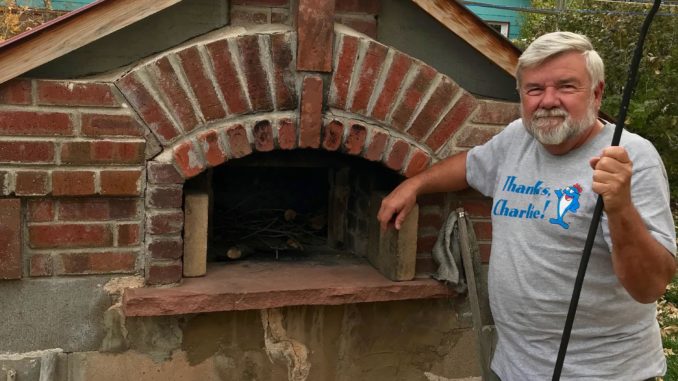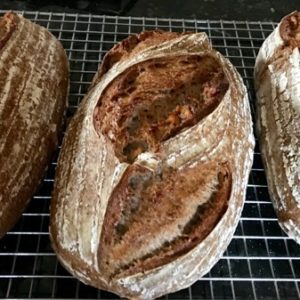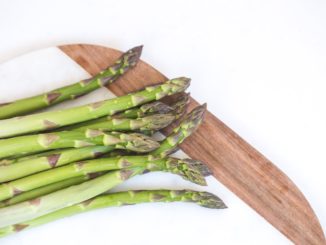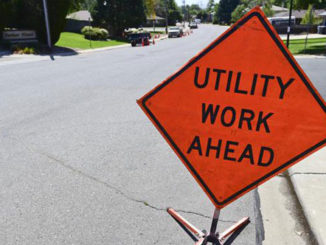
Reith Miller used to show up early on Tuesday mornings at Maggie McCullough’s French Bakery in Fort Collins. It was the only day the bakery made walnut rye bread and if you didn’t show up early, you’d be out of luck.
And then one day something happened. Maggie, exhausted from so many early morning baking sessions, ran out of steam and closed up shop. Miller was devastated.
Not one to take disappointments lying down, he began thinking about baking his own bread. He talked with bread bakers, did extensive reading and then experimenting. “We started giving him bread books for his birthday. We’d find bread dough being proofed in the bathroom,” his wife Lauren said.

When perfectly scored with a razor blade, bread splits open as it expands. Holes in the bread indicate a perfect batch.
By 2004, Reith had built an oven in his back yard and was fast becoming an expert. When he retired from his career as an engineering technician for the Forest Service, he relished the free time he had to dig ever deeper into his passion for really good bread.
“I grew up on the East Coast and I remember the crunchy crust of hard rolls. My mother baked bread. I spent time in Europe during my days in the Navy and discovered the joys of flavorful European bread with amazing crusts. I couldn’t find anything like that in Fort Collins after Maggie’s closed,” he said.
He can go on and on about the history of bread. “It determined your social class,” he explained. “The whiter the bread you could afford, the higher up you were on the social scale. These days the bleaching process used to whiten flour removes much of its nutritional value. It’s not good for us.”
Reith began seeking out heirloom grains and grinding his own flour using first a manual mill, then switching to a motorized stone mill that he had made to order. He has found sites online to buy rye, wheat, spelt, kamut, emmer and einkorn—grains that make for superior bread with nutritional value.
Perhaps because he has the mind of an engineer, he is dedicated to preciseness. He has developed a thick notebook of spread sheets that tell him in percentages exactly how much flour, yeast, water and salt are needed in any given recipe.

Reith Miller scores bread loves in his home kitchen.
It takes three days to complete his baking process. He no longer uses commercial yeast. Instead he begins the process by adding flour and water to a starter that resides permanently in his refrigerator, and allows it to sit at room temperature overnight.
Around noon the following day, he mixes up the dough and allows it to sit for an hour. Unlike most bread dough, he keeps his “sticky,” by incorporating more water than is traditional. It is more difficult to work with but makes for a better product. After an hour or so, he dumps the bread on a counter, punching it down and using a “stretch and fold” process before allowing it to stand for another hour. After another “stretch and fold,” the bread is formed into loaves, placed into floured wooden baskets and covered with plastic to be refrigerated overnight.
On day three, the partially risen dough is removed from the baskets and “scored” with a lame, a double-edged razor, a process that allows the bread to expand as it bakes. Then the still cold bread is slid into a 460-degree oven using a long wooden paddle. A cup of water poured into a pan just below the baking stone assures adequate moisture to create the coveted crunchy crust.
Twenty minutes later the bread gets turned using the wooden paddle. By this time, it is obvious that rising has taken place during baking. Those little slits made by the lame have grown wide with “ears” on the edges, a sure sign that things are going well.

Reith Miller checks out his artisan bread as it bakes in the oven. He uses a wood paddle to move the loaves.
After 40 minutes, the bread is done. This batch just happens to be walnut rye. There are three beautiful loaves complete with “ears” and small “holes,” both signs of success. One loaf goes home with me. It’s still warm by the time I get there, so I must have a piece before it cools. And I must have a sandwich for dinner and toast for breakfast the next morning.
“It dries out fast in this climate,” Reith warns. Put it in plastic and refrigerate after day one. I decide to freeze the rest of it, just so I can look at it for a while longer.
Reith Miller’s favorite bread books are A Baker’s Book of Techniques and Recipes, Jeffrey Hamelman, The Bread Baker’s Apprentice by Peter Reinhart and Bread Alone by Daniel Leader. He recommends trying a Greek Celebration Bread for a holiday treat.
Support Northern Colorado Journalism
Show your support for North Forty News by helping us produce more content. It's a kind and simple gesture that will help us continue to bring more content to you.
BONUS - Donors get a link in their receipt to sign up for our once-per-week instant text messaging alert. Get your e-copy of North Forty News the moment it is released!
Click to Donate



